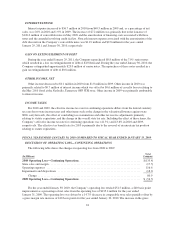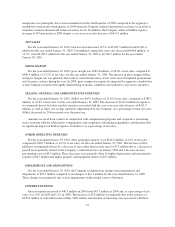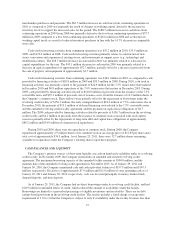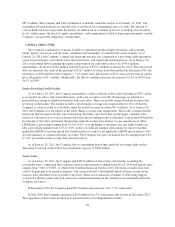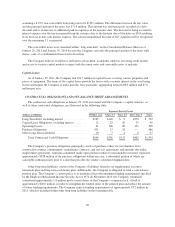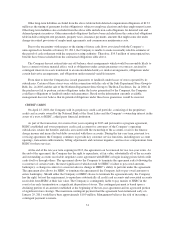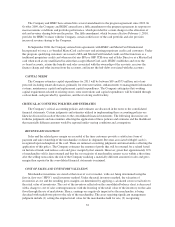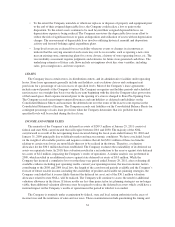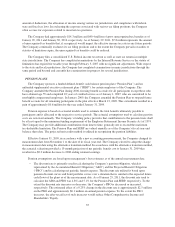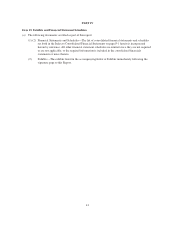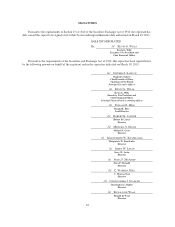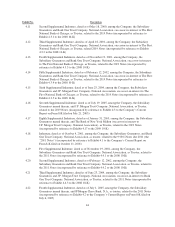Saks Fifth Avenue 2010 Annual Report Download - page 35
Download and view the complete annual report
Please find page 35 of the 2010 Saks Fifth Avenue annual report below. You can navigate through the pages in the report by either clicking on the pages listed below, or by using the keyword search tool below to find specific information within the annual report.• To the extent the Company remodels or otherwise replaces or disposes of property and equipment prior
to the end of their assigned depreciable lives, the Company could realize a loss or gain on the
disposition. To the extent assets continue to be used beyond their assigned depreciable lives, no
depreciation expense is being realized. The Company reassesses the depreciable lives in an effort to
reduce the risk of significant losses or gains at disposition and utilization of assets with no depreciation
charges. The reassessment of depreciable lives involves utilizing historical remodel and disposition
activity and forward-looking capital expenditure plans.
• Long-lived assets are evaluated for recoverability whenever events or changes in circumstances
indicate that the carrying amount of such assets may not be recoverable, such as opening a new store
near an existing store, announcing plans for a store closure, a history of store operating losses, etc. The
recoverability assessment requires judgments and estimates for future store generated cash flows. The
underlying estimates of future cash flows include assumptions about key store variables, including
sales, gross margin rates, and store expenses.
LEASES
The Company leases certain stores, its distribution centers, and its administrative facilities under operating
leases. Store lease agreements generally include rent holidays, rent escalation clauses and contingent rent
provisions for a percentage of sales in excess of specified levels. Most of the Company’s lease agreements
include renewal periods at the Company’s option. The Company recognizes rent holiday periods and scheduled
rent increases on a straight-line basis over the lease term beginning with the date the Company takes possession
of the leased space. Rent expense incurred prior to the opening of a store is charged to Store Pre-Opening Costs.
The Company records tenant improvement allowances and rent holidays as deferred rent liabilities on the
Consolidated Balance Sheets and amortizes the deferred rent over the terms of the lease to rent expense in the
Consolidated Statements of Income. The Company records rent liabilities on the Consolidated Balance Sheets for
contingent percentage of sales lease provisions when the Company determines that it is probable that the
specified levels will be reached during the fiscal year.
INCOME AND OTHER TAXES
The majority of the Company’s net deferred tax assets of $249.5 million at January 29, 2011 consist of
federal and state NOL carryforwards that will expire between 2011 and 2030. The majority of the NOL
carryforward is a result of the net operating losses incurred during the fiscal years ended January 30, 2010 and
January 31, 2009 principally due to difficult market and macroeconomic conditions. We have concluded, based
on the weight of all available positive and negative evidence that all but $30.1 million of these tax benefits
relating to certain state losses are more likely than not to be realized in the future. Therefore, a valuation
allowance for the $30.1 million has been established. The Company evaluates the realizability of its deferred tax
assets on a quarterly basis. In 2010, this evaluation resulted in a net reduction to the reserve against state deferred
tax assets of $2.2 million, impacting the Company’s results of operations. A similar analysis was performed in
2009, which resulted in an additional reserve against state deferred tax assets of $3.0 million. While the
Company has incurred a cumulative loss over the three-year period ended January 29, 2011, after evaluating all
available evidence including past operating results, current year operating income, the macroeconomic factors
contributing to the 2008 and 2009 fiscal loss, the length of the carryforward periods available and the Company’s
forecast of future taxable income, including the availability of prudent and feasible tax planning strategies, the
Company concluded that it is more likely than not the deferred tax asset, net of the $30.1 million valuation
allowance related to state NOLs, will be realized. The Company will continue to assess the need for additional
valuation allowance in the future. If future results are less than projected or tax planning strategies are no longer
viable, then additional valuation allowance may be required to reduce the deferred tax assets which could have a
material impact on the Company’s results of operations in the period in which it is recorded.
The Company is routinely under examination by federal, state and local taxing authorities in the areas of
income taxes and the remittance of sales and use taxes. These examinations include questioning the timing and
34


